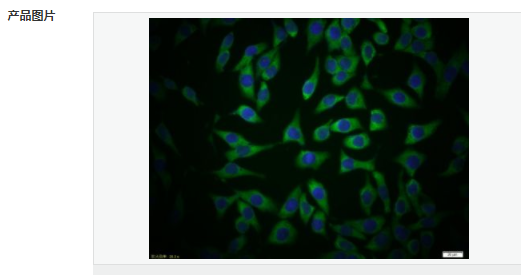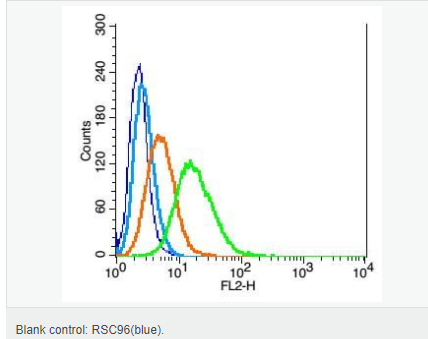

貨號(hào)
產(chǎn)品規(guī)格
售價(jià)
備注
BN41751R-50ul
50ul
¥1486.00
交叉反應(yīng):Human,Mouse,Rat(predicted:Dog,Pig,Horse,Rabbit) 推薦應(yīng)用:ELISA
BN41751R-100ul
100ul
¥2360.00
交叉反應(yīng):Human,Mouse,Rat(predicted:Dog,Pig,Horse,Rabbit) 推薦應(yīng)用:ELISA
BN41751R-200ul
200ul
¥3490.00
交叉反應(yīng):Human,Mouse,Rat(predicted:Dog,Pig,Horse,Rabbit) 推薦應(yīng)用:ELISA
產(chǎn)品描述
| 英文名稱(chēng) | ERG/KCNH2 |
| 中文名稱(chēng) | 特異性鉀離子通道蛋白抗體 |
| 別 名 | ERG; ERG1; H ERG; HERG 1; HERG; HERG1; LQT 2; LQT2; Potassium channel HERG; SQT1; Voltagegated potassium channel, subfamily H, member 2; KCNH2_HUMAN. |
| 研究領(lǐng)域 | 腫瘤 免疫學(xué) 細(xì)胞周期蛋白 通道蛋白 |
| 抗體來(lái)源 | Rabbit |
| 克隆類(lèi)型 | Polyclonal |
| 交叉反應(yīng) | Human, Rat, (predicted: Mouse, Dog, Pig, Horse, Rabbit, ) |
| 產(chǎn)品應(yīng)用 | ELISA=1:5000-10000 Flow-Cyt=1μg /test ICC=1:100-500 not yet tested in other applications. optimal dilutions/concentrations should be determined by the end user. |
| 分 子 量 | 127kDa |
| 細(xì)胞定位 | 細(xì)胞膜 |
| 性 狀 | Liquid |
| 濃 度 | 1mg/ml |
| 免 疫 原 | KLH conjugated synthetic peptide derived from human HERG:1001-1159/1159 <Cytoplasmic> |
| 亞 型 | IgG |
| 純化方法 | affinity purified by Protein A |
| 儲(chǔ) 存 液 | 0.01M TBS(pH7.4) with 1% BSA, 0.03% Proclin300 and 50% Glycerol. |
| 保存條件 | Shipped at 4℃. Store at -20 °C for one year. Avoid repeated freeze/thaw cycles. |
| PubMed | PubMed |
| 產(chǎn)品介紹 | The potassium voltage gated channel, subfamily H (eag related), member 2 (KCNH2) gene encodes a voltage-gated potassium channel which has an important role in cardiac action potential repolarization in the mammalian heart. Mutations in KCNH2 have been shown to cause chromosome 7-linked congenital long QT syndrome, a disorder associated with delayed cardiac repolarization, prolonged electrocardiographic QT intervals, and the development of ventricular arrhythmias. KCNH2 channels are an important target for many drugs, and have emerged as a significant type of cardiac ion channel.Highly expressed in heart and brain. Function: Pore-forming (alpha) subunit of voltage-gated inwardly rectifying potassium channel. Channel properties are modulated by cAMP and subunit assembly. Mediates the rapidly activating component of the delayed rectifying potassium current in heart (IKr). Isoform 3 has no channel activity by itself, but modulates channel characteristics when associated with isoform 1. Subunit: The potassium channel is probably composed of a homo- or heterotetrameric complex of pore-forming alpha subunits that can associate with modulating beta subunits. Heteromultimer with KCNH6/ERG2 and KCNH7/ERG3. Interacts with ALG10B (By similarity). Heteromultimer with KCNE1 and KCNE2. Subcellular Location: Membrane; Multi-pass membrane protein. Tissue Specificity: Highly expressed in heart and brain. Post-translational modifications: Phosphorylated on serine and threonine residues. Phosphorylation by PKA inhibits ion conduction. DISEASE: Defects in KCNH2 are the cause of long QT syndrome type 2 (LQT2) [MIM:613688]. Long QT syndromes are heart disorders characterized by a prolonged QT interval on the ECG and polymorphic ventricular arrhythmias. They cause syncope and sudden death in response to exercise or emotional stress. Deafness is often associated with LQT2. Defects in KCNH2 are the cause of short QT syndrome type 1 (SQT1) [MIM:609620]. Short QT syndromes are heart disorders characterized by idiopathic persistently and uniformly short QT interval on ECG in the absence of structural heart disease in affected individuals. They cause syncope and sudden death. Similarity: Belongs to the potassium channel family. H (Eag) (TC1.A.1.20) subfamily. Kv11.1/KCNH2 sub-subfamily. Contains 1 cyclic nucleotide-binding domain. Contains 1 PAC (PAS-associated C-terminal) domain. Contains 1 PAS (PER-ARNT-SIM) domain. SWISS: Q12809 Gene ID: 3757 Database links: Entrez Gene: 3757 Human Entrez Gene: 16511 Mouse Omim: 152427 Human SwissProt: Q12809 Human SwissProt: O35219 Mouse Unigene: 647099 Human Unigene: 6539 Mouse Unigene: 10970 Rat Important Note: This product as supplied is intended for research use only, not for use in human, therapeutic or diagnostic applications. |

